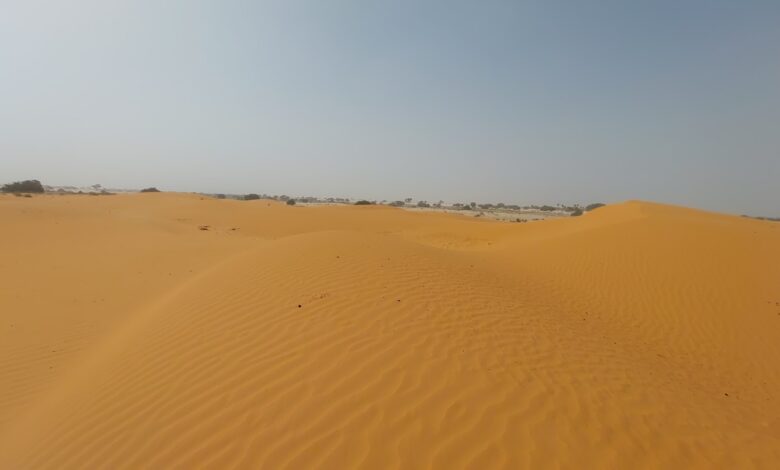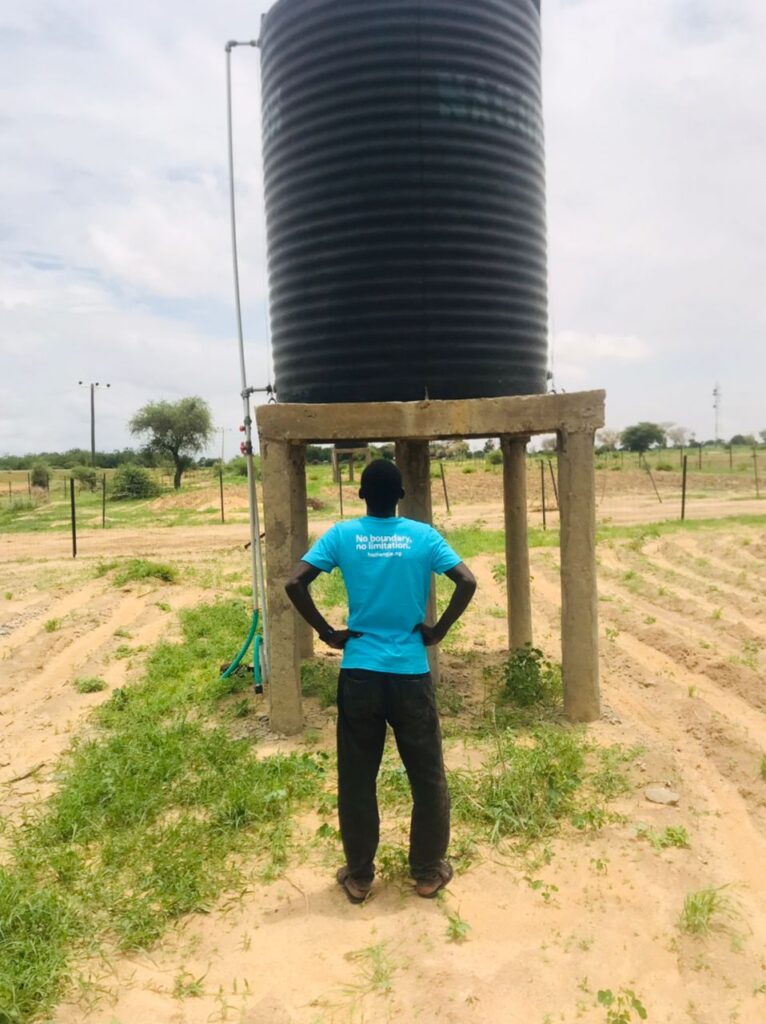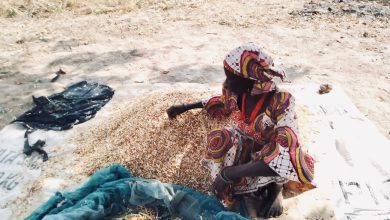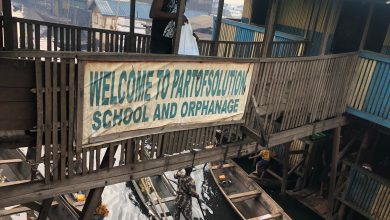Dead Trees, No Water, Missing Money; The Truth Of Yobe’s “Great Green Wall”
The northeastern state of Yobe is at the heart of the campaign to improve vegetation cover and livelihoods of rural areas in Nigeria. However, the effort is being marred by low inefficiency and community buy-in.

The Nigerian government is investing resources to build a corridor of trees in eleven states in the North to combat desertification and improve the livelihoods of rural communities. However, in the frontline northeastern state of Yobe, the ambitious afforestation initiative has been beset by a series of challenges.
Since the flag off of the Nigerian section of the Great Green Wall project, authorities have been planting economic and forest trees to establish a 1,500KM long belt. The effort focuses on the worst affected states of Adamawa, Borno, Yobe, Bauchi, and Gombe in the Northeast and Kano, Katsina, Kebbi, Jigawa, Sokoto, and Zamfara in the Northwest.
The initiative hopes to tackle desertification by restoring land, curbing the alarming rate of desertification, and expanding the Sahara desert. In Yobe, the State Government has also rolled out a tree planting initiative with similar land restoration targets, climate action, and the creation of jobs.
“As from 2021, 10 million assorted tree seedlings will be raised each year up to 2024 where a target of 40 million assorted seedlings will be raised, planted, and nurtured,” the Governor, Mai Mala Buni, was quoted to have said during the launch of the campaign and the Climate Change Action Plan for Yobe at Dusuwa Forest Reserve.
In December, the Governor signed an ₦163,953, 384,000 ($381,286,939) state budget into law. The budget included operational and expenditure funding for bodies directly linked to the campaign. For example, the Ministry of Environment had a line item for Procurement of Seeds and Seedlings worth 13,000,000.00 and Tree Planting and Landscaping for ₦60,000,000.
North East Arid Zone Development Programme also had line items on Procurement of Seeds and Seedlings for ₦7 million ($15,852), while the afforestation Programme budgeted ₦12 million ($27,000) for tree planting and landscaping.
HumAngle spoke to some residents of the host communities and reviewed the afforestation efforts in the state. Findings show an alarming pattern of shortcomings and inefficiencies that have affected the sustainability of the investment.

Three locations of the Great Green Wall project were observed in the Chinbusko village, which is part of Karasuwa Local Government Area in Northern Yobe. In each of the “shelter belts”, about 1,500 trees were reportedly planted; some of the sites had signs indicating a motorised borehole was constructed, but that was not visible.
During a visit to one of the sites in July only a few of the trees appeared to have survived out of the thousands planted in a four kilometre-long section of the shelter belt. The location also had wire fencing, an overhead tank and support equipment for the water supply to sustain the project, especially during the dry season.
However, the tank had no water, and even if it did, some of the pipes for watering the trees were disconnected.
At another site, a community member, Malam Adamu Rabiu, lamented that he had not received the monthly ₦20,000 stipend promised for looking after the three kilometres shelter belt, even though he says the appointment was not official.
According to Adamu, last year, the plantation ran into issues with plants dying and parts of the land taken over as farmland by members of the local community. A few months ago, a generator was brought for the borehole, but it has not been used after testing. Since then, a component has been stolen, and the overhead tank has fallen.
“Look at the trees. Only a few survive,” said a different community member, Malam Haruna, explaining that the project has not been functional since 2020 after starting with the planting of some trees.
He laments that the community doesn’t understand its importance because they are not sufficiently sensitised. This shortcoming, alongside poor participation from the locals, was affecting sustainability.
The afforestation site at Atta village was a six-kilometre shelter belt with only a few trees visibly alive; the perimeter fence had collapsed, and there was not an overhead tank similar to other locations.
At another location, a 5-kilometre site at Rumfar Kara, the story seems similar to the previous ones. It had a signpost with the National Agency for the Great Green Wall and the contractor written on it. The site had no apparent trees, and the overhead tank was not working.

“See, this project is near my farm; as you can see, some of the plantations have died and are not growing. I have never seen someone coming here to see the level of the growth of the plantation,” said a nearby farmer, Saidu Manu.
He complained about a lack of community participation and incentive to assist. Officials managing the project “just come and do their plantation and go away and only appear from time to time at the project location,” he said.
Aminu Shuibu runs one of the projects in Chinbusko after his appointment to look after the four kilometres shelter belt alongside colleagues about ten months ago. He complains about not receiving a stipend despite the promise of payment.
Aminu says the trees at the site had died because of the inadequate water supply, and only a few survived. This resulted from issues with the generator and the theft of an underground pipe network for watering the plantation.
At Garanda, a few kilometres from Nguru, there are about three locations in the town. However, they have had a similar low survival rate.
“I don’t know the importance of this project. Some years back, some people came and planted trees and brought overhead tanks to water the trees, but there was no water in the overhead, and the trees died. Some people are using the land to do their farming,” Malam Adamu, a farmer near a Great Green Wall project said.
This concern was shared by Mallam Manu, a resident of Kabaru village, which has about three locations of the Great Green Wall project. “We have only seen them from time to time, and they told us that this project is aimed at combating desertification and encroachment.”
He adds that they are yet to feel the project’s impact because desertification has affected farmlands and led to low crop production for the past four years.
“The farmland is not yielding any crops. As you can see, we are shifting from one place to another in search of productive land.”
However, another resident, Musa Manu, believes the project significantly impacts lives and property, highlighting its potential role as a windbreaker.
“As you can see, this is the Sahel region where there is not enough forest and plantation of trees, and we are experiencing high-speed wind that has the tendency of the destruction of property and lives.”
He says if adequately managed, the afforestation project will help reduce the impact of wind on the vulnerable communities and combat the widespread desertification in northern Yobe.
The weak awareness among the local population also extends to the pastoralist community. Jauro Manu, a herder, initially complained about it, he says. But later he understood that when the trees grow up, they will serve as windbreakers; preventing the wind from causing destruction and sheltering cattle when there is heavy rain or wind.
HumAngle’s head of climate security desk, Murtala Abdullahi, describes the Great Green Wall as an essential measure for protecting the livelihoods of farmers and herders especially.
He adds that “apart from addressing the challenges of land degradation, the project could potentially slow down or alter the migration of herders, a contributing factor to deadly conflict between the communities.”
Yobe State Government’s Tree Planting and Climate Action
Yobe is one of the frontline sub-Saharan states in the country, with some parts heavily affected by desert encroachment at an alarming rate. The State Governor Mai Mala Buni flagged off a tree planting and climate change action on the 29th July 2020 as part of the government’s effort to safeguard the environment against man-made and natural factors. The programme targets the planting and raising to maturity of five million seedlings each year for four years from 2020 (20 million in four years).
Part of the implementing strategy of the project is to provide job opportunities to hundreds of Youths across the state who would be saddled with the responsibility of monitoring and care to ensure proper growth and development of the trees for efficient and effective sustainability.
Two years after the commencement of the project, we embarked on an investigation as a result of concerns by people concerning its success and progress or otherwise.
On a visit to Dusuwa Forest Reserve Lawan Kalam of Damaturu Local Government – a Gum Arabic plantation where the project was commissioned, we observed that farmers were using the lands for farming during the rainy seasons with the agreement that they would be taking care of the trees.
But the question is, how will the trees be taken care of after the rainy season when the farmers have harvested their farm produce?
We also observed that the trees in the plantation were not at a uniform growth level which is one of the characteristics of a thriving growing plantation and could be attributed to inadequate maintenance of the plantation.
In an interview with Muhammad Abdulrahim, a Youth/Environmental Activist who is also a landscaper and a nursery gardener, on his views about the entire tree planting programme, he said, “Planting a tree is important but beyond that is the commitment in managing and caring for it to grow so it can mature and benefit the community by fighting desert encroachment.
“The tree planting by the Ministry of Environment is good, but the problem is improper management and inadequate awareness and sensitisation to the beneficiary communities,” adds Muhammad.
He further said that “You cannot plant a tree for Afforestation and then leave it to natural growth, without providing necessary and proper management practices which are essential and prerequisites for effective growth and sustainable impact. So, the inconsistent commitment to taking care of the trees by authorities is one of the setbacks that affect the programme. Even if they manage it, they are not doing it correctly. Some of the communities too did not take the trees with importance, and they didn’t commit themselves to take care of them.”
Speaking on the best approach to be taken by the government, Muhammad indicated that Government should sensitise the community first before it embarks on tree planting. If the communities are aware of the importance and uses of the trees, they will definitely take care of it, therefore if you give them they would treat it with importance.
Government should put in place serious commitment as well as genuine political and administrative will in order to deliver for the benefit of the community, because environmental and climate change consequences may result in deaths and destroy properties as we are currently observing because of the flooding, Muhammad said.
Another resident of Yobe State, Musa Mohammed, who is a climate change champion has also commended the state government for its foresight in coming up with the project, especially since the Northern part of the state has been affected by desert encroachment.
He pointed out that “The tree planting campaign by Yobe State Government serves as an important stage in consideration of the State as an Arid land and the kind of challenges the state is facing in terms of inadequate tree plantations. The government did so much in terms of providing boreholes, fencing the locations, and also bringing facilitators and monitors to see how they could make it to be successful.
Unfortunately, there are some issues because of human imperfection. Therefore we cannot say whether the project is fully achieved or not. What I can say here is a lack of commitment regarding the management and also a lack of giving a progress report update to people more especially to the community so they can be aware and make input to correct government where applicable.”
Accordingly, the climate change action and tree planting campaign were arranged to engage Youth volunteers to be in the position of caring for and managing the trees up to maturity, thereby providing job opportunities to teeming Youth with a stipend at the end of the month. However, since the commencement of the project, nothing of such arrangement was fulfilled even while a list of organisations was submitted to the Ministry for consideration of their request.
In a separate visit to Yobe State Afforestation Programme, we found that the seedlings were there since 2020, some of which have begun to grow while others have decayed on empty polythene bags despite the fact that some people are still looking for the seedlings to plant it.
Yobe State Afforestation Programme Office has been the custodian of the seedlings that were raised from different parts of the State prior to the official flag off of the tree planting and climate change action by Yobe State in 2020.
In an interview with an Environmental expert, Dr Babagana Boso of Yobe State University, he said that “the tree planting campaign and climate change action is a right thing in the right direction. But since its inception, the visibility of the project has been insignificant. If I remember, about two million seedlings were said to be planted across the state to draw back the effect of climate change, due to desertification, drought and deforestation. In a nutshell, as far as I’m concerned, there is less impact, if at all there is, on the climate action so far.”
On the appropriate measures to be taken for effective delivery of the project, Dr Boso stressed that “The appropriate measures to be taken to achieve success is to ensure sincere commitment, timely release of funds and logistics as well as the proper timing of planting season.
A monitoring and evaluation unit must be constituted to ensure the right thing is done. The remote tree planting campaign should be followed up with sincerely and genuine planting in the right places. Once this would be observed, the project would achieve success”.
*This report was produced under the HumAngle Accountability Fellowship with support from the MacArthur Foundation.
Support Our Journalism
There are millions of ordinary people affected by conflict in Africa whose stories are missing in the mainstream media. HumAngle is determined to tell those challenging and under-reported stories, hoping that the people impacted by these conflicts will find the safety and security they deserve.
To ensure that we continue to provide public service coverage, we have a small favour to ask you. We want you to be part of our journalistic endeavour by contributing a token to us.
Your donation will further promote a robust, free, and independent media.
Donate HereStay Closer To The Stories That Matter




